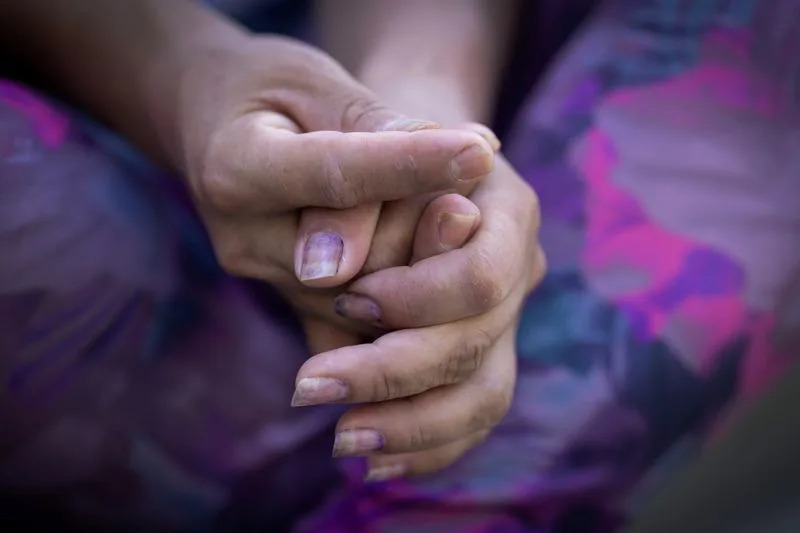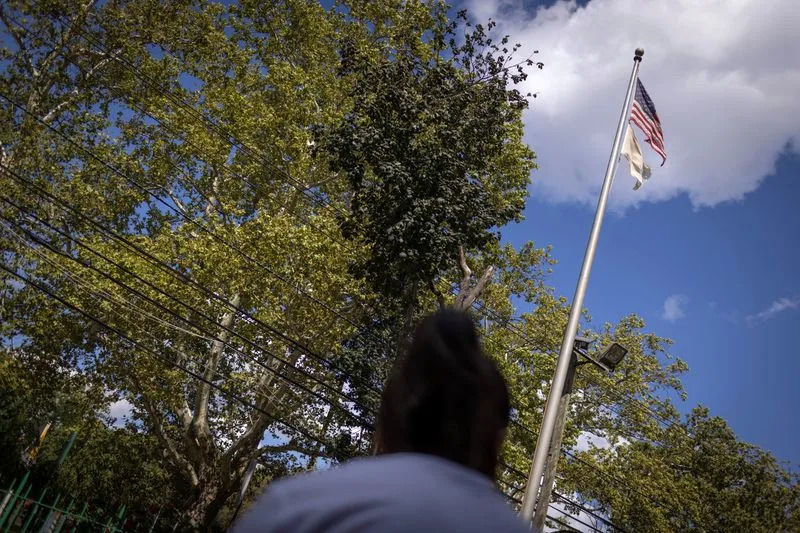MATTHIAS SCHRADER
Fri, September 29, 2023


APTOPIX Climate Alps Glaciers Photo Gallery
Ski lifts, resorts, cabins and huts dot the landscape — and have done so for decades. But glaciers are also one of the most obvious and early victims of human-caused climate change, and as they shrink year by year, the future of the mountain ecosystems and the people who enjoy them will look starkly different.
Glaciers — centuries of compacted snow and ice — are disappearing at an alarming rate. Swiss glaciers have lost 10% of their volume since 2021, and some glaciers are predicted to disappear entirely in the next few years.
At the Freigerferner glacier in Austria, melting means the glacier has split into two and hollowed out as warm air streamed through the glacier base, exacerbating the thaw.
Gaisskarferner, another glacier that forms part of a ski resort, is only connected to the rest of the snow and ice by sections of glacier that were saved over the summer with protective sheets to shield them from the sun.
But the losses go beyond a shorter ski season and glacier mass.
Andrea Fischer, a glaciologist with the Austrian Academy of Sciences, said the rate of glacier loss can tell the world more about the state of the climate globally, and how urgent curbing human-caused warming is.
“The loss of glaciers is not the most dangerous thing about climate change," said Fischer. “The most dangerous thing about climate change is the effect on ecosystems, on natural hazards, and those processes are much harder to see. The glaciers just teach us how to see climate change.”
From a vantage point above the mountains in a light aircraft, the changing landscape is obvious. The glaciers are noticeably smaller and fewer, and bare rock lies in their place.
Much of the thawing is already locked in, so that even immediate and drastic cuts to planet-warming emissions can’t save the glaciers from disappearing or shrinking in the short term.
While the extent of glacier melt can create awareness and concern for the climate, “being only concerned does not change anything,” Fischer said.
She urged instead that concern should be channeled into "a positive attitude toward designing a new future," where warming can successfully be curbed to stop the most detrimental effects of climate change.
___
Associated Press climate and environmental coverage receives support from several private foundations. See more about AP’s climate initiative here. The AP is solely responsible for all content.
The epic European trek that is being transformed by climate change
Jasper Rees
Fri, September 29, 2023

A party of skiers pitch their tents on the Mer de Glace glacier in 1965 – Switzerland’s glaciers have lost 10 per cent of their volume in the summers of 2022-23 - Paul Popper/Popperfoto
The Col du Grand Ferret rises to just over 2,500 metres. It requires a couple of hot, sweaty hours to lug a rucksack up from the valley floor but the reward, as you stand on the shoulder between two countries, is to have your breath taken away. To our left, falling away into a deep long valley, is Italy. To our right, in a jostling recession of crags, is Switzerland. And straight ahead, sliding down from the summit of Mont Dolent, is a magnificent glacier.
The Glacier de Pré de Bar is a wide prairie of corrugated ice tapering to a narrow point. With only slightly longer arms, I felt as if I could reach out and touch it. But every year those imaginary arms would have to stretch a little further. Since 1990, the glacier has been losing an average of 18 metres a year. To stand here is to look at a snapshot of a changing landscape.

Jasper Rees embarking on the Tour du Mont Blanc
It was announced that Switzerland’s glaciers had lost 10 per cent of their volume just in the summers of 2022-23 – the same volume as was lost between 1960 and 1990. Throughout the Alps, glaciers are retreating at pace: the chance to view them at all may soon be gone forever.
My partner Emily and I were there this summer to trek for 10 days and 170km around the route that circles the Mont Blanc range. The Tour du Mont Blanc is epic, and it is knackering. Every day we would gain around 1,000 metres before descending an equivalent amount to that night’s accommodation. On the most gruelling section there were three cols, each loftier than the last until we reached the TMB’s highest point at Col des Fours (2,665 metres). By the end we had climbed 10,000m. Everest is 8,849m. Hiking poles, about which we’d previously been snobby, are a sine qua non.
Hannibal is thought to have used one of these passes to invade Italy on elephants. But the full circuit was first completed in 1767 by Horace-Bénédict de Saussure, a Swiss geologist who circumnavigated the range in search of a route up the Alps’ highest peak. There’s a statue of him in Chamonix.
In common with most hikers on the route, of all ages and from all continents, going it alone or in guided groups, we took the anticlockwise option. Thus the massif was always on our left: the big mother mountain herself, smoothly aproned in virgin-white snow, and her neighbours, snaggle-toothed Aiguilles and Jorasses as pointy as witches’ hats.
The TMB has everything: roaring rivers and thunderous waterfalls; stubbly boulder fields and dazzling wild-flower pastures; sky-wide panoramas and dense enclosing forest; clear skies and cleansing storms; intense heat then, at the Col des Montets (1,461 metres) between Switzerland and France, finger-numbing cold.
Above all – literally – there are those glaciers. I lost count of quite how many cling to the sides of the massif. They have intriguing names – Bionnassay, Frébouze, Triolet – and offer up endless variety. Some glisten white, others are muddily pockmarked. The Miage, a huge flat motorway flowing down the Italian side above Courmayeur, is entirely buried in rocky moraine. One evening, having walked down into Switzerland, we sat in our hotel’s beer garden and gazed for an hour at the dramatic Glacier du Dolent. And then on the penultimate day came the climax: the Glacier d’Argentière, a hoveringly high cliff of blue ice that resembled the flank of a calved berg.
I call it the climax, but it really shouldn’t have been. The frustration is that the Mer de Glace, the largest glacier in France, is nowadays barely visible from the route. For all its grandeur, by the time it rounds the foot of Montenvers into an opening above Chamonix, it has more or less dwindled to nothing.

'A huge flat motorway': the Miage glacier - Jean-Didier RISLER/Gamma-Rapho via Getty
This wasn’t always the case. In 1700 the Mer de Glace flowed so low it threatened to block the valley. In 1855 it was three kilometres further downstream further than it is today. Then-and-now photographs reveal how much it has shrunk over the past century. Tourists who take the train up to inspect it are confronted with markers that measure how fast it is creeping back up the mountain.
But the length, I am told by Chamonix-based glaciologist Ludovic Ravanel, is not the main problem. “The length is related to many factors,” he says. “The thickness is much more relevant. Last year at Montenvers the loss in thickness was 16.50 metres. The current thickness is only 30 metres. In the western Alps the loss was 6.2 percent of the total volume of the glaciers.”
The theory with glaciers is that in winter the volume recuperates after the summer melt. But the summers are getting longer and hotter and the winters warmer and wetter. “It takes a lot of time in the autumn to get cold again,” says Pica Harry, a mountain guide who grew up in Chamonix. “I’ve seen the glaciers melting every year and it’s worse and worse the past ten years. I feel the mountains getting dry and a bit more rotten. People will come to see the dying glaciers maybe more in a climate change interest than really for the beauty of the mountains.”

The receding Mer de Glace - EMMANUEL DUNAND/AFP via Getty
While last year was critical, this August a weather balloon 50 miles north of Chamonix measured the zero-degree line – the altitude at which the temperature falls below freezing – at 5,300 metres. That’s 500 metres higher than the summit of Mont Blanc, and a record since monitoring started in 1954.
The consequence of global warming in the Mont Blanc massif, says Ravanel, is to defreeze permafrost that for millennia has acted as cement to hold rocks in place. “Last year the piece of ice which I had dated to 6,250 years old totally disappeared. We are losing paleoclimatic archives in the Alps. We are losing very very old ice.”
Melting ice causes increasing rockfalls, some of them massive, and the debris now scars the flatter slopes of the glaciers. How bad can it get? “I have colleagues in Switzerland who have modelled the evolution of the glaciers,” says Ravanel. “At the end of the century we should have lost between 95 and 99 percent of the surface of the glaciers in the Alps. But the Intergovernmental Panel on Climate Change reports the situation is worse and worse, so it could be before the end of the century.”
They’re still there, and still spectacular, and you can see them in all their majesty on one of the world’s great walks. But hurry.

Jasper Rees in action
How to do the Tour de Mont Blanc
The Tour du Mont Blanc is most popularly done in high summer when there is more chance of sun, warmth and ski lifts to take you to and from Chamonix and Courmayeur. It is best booked well in advance, and through a company which knows the accommodation options. Guided treks are available, but we booked a self-guided trip through Mont Blanc Treks, which is owned and run by local guides, at a cost of £1,795 each. Also recommended as a helpful independent guide is Mags Nixon.
Most of the accommodation is in three-star half-board hotels, but for the more communally-minded there are cheaper refuges. (There is no hotel anywhere near the France-Italy border section, so on that night a refuge is the only option.) Some companies arrange baggage transfer but most hikers carry all they need in rucksacks. Even in summer, that should include warm clothing as the temperature can plummet. The Tour of Mont Blanc (Cicerone) has maps and routes in both directions, with variants in case of bad weather.
While the paths are clearly signed, and it’s very difficult to get lost, it essentially to have a base level of fitness. But it’s hazard-free hiking, not climbing. Those who wish to flirt embrace a more uncomfortable gradient can opt for the high variant route over the reportedly tricky Fenêtre d’Arpette in Switzerland.














14/ 14
Climate Alps Glaciers Photo Gallery
























